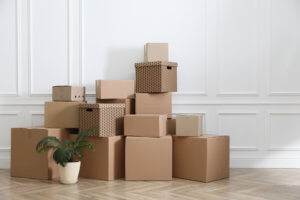Getting ready for a move? Chances are, it’s not one of your favorite experiences. For many people, moving can be overwhelming. Oftentimes, the sense of overwhelm comes from a lack of preparation.
Tackling many steps at once, scrambling at the last minute to get things done, and general challenges from procrastination can easily wear anyone out. The antidote to moving pains? Planning and preparation.
Full-service moving companies can pack all of your things for you. They’ll even bring all of the packing supplies, saving you the hassle of hunting for boxes and other necessities. A full-service mover is like a big red line through some pretty major lines on your moving to-do list.
If you’re going to handle your packing, don’t stress. We’ve put together a checklist for your packing and moving essentials, to help you get prepped and ready for moving day.
Boxes
Crucial to any packing project are boxes. You can choose to get new boxes from a moving or shipping store or opt for finding free boxes. If you choose the latter, try liquor stores, book stores, or grocers to see if they have some spare boxes you could have. Make sure the boxes you take are in good, sturdy condition. You’ll need to be able to move them with confidence.
Whatever your approach, make sure you collect boxes in a variety of sizes. You’ll need smaller boxes for heavy items such as books. Larger boxes will suit items like bedding, clothing, linens, and other lighter-weight items.
Specialty boxes can be particularly helpful for your breakable items. Dish boxes will help reduce the risk of damage or breaks. Those designed specifically for glasses will provide padding in between to avoid friction or clashes. Clothing boxes come with a rod, saving you the time of unhanging and folding your wardrobe – just hang them up for transport, and transfer them directly into your new closet.
Padding
Throwing everything in a box and hoping for the best isn’t worth the risk. Make sure you have the right padding and cushioning to keep your items safe.
Foam sheets are great for padding between items such as dishes or records. Bubble roll is best for wrapping large or oddly shaped breakable items, including artwork or vases. Newspaper can also be helpful, but keep in mind it’s less effective. Don’t use newspaper on ceramics or porous materials as the ink may stain.
You can supplement your padding supplies by using items from around your house. Rags, towels, clothing, and linens are great options to pad semi-breakable items.
Labeling
Label, label, LABEL. Don’t skip this step! You’ll be glad you took the time to clearly and thoroughly label your boxes when it’s time to unpack. Labels not only help keep items protected as needed, but they’ll ensure your movers deliver the boxes to the right room when you arrive at your new home.
We recommend using a color-coded system for labeling, to make it very clear who and what your boxes belong to. Whether that means choosing a color for each room or each person, take the guesswork out of box organization.
You can either use colored markers to write directly on your boxes or use colored labels to draw attention. Either way, make sure you clearly label multiple sides and the top of your boxes as they shift during moving.
Sealing
You’ve come this far… Don’t cut corners. While you may be tempted to pick up a cheap roll of packing tape, don’t do it. Spend a few extra dollars on quality packing tape. Cheap tape is less sticky and more prone to breaking or splitting.
You’ll likely need more tape than you think, so buy it in bulk. If you really want to make matters easier on yourself, grab a tape gun. You’ll save yourself from hunting for the end and using scissors (or your teeth) to cut it each time.
Talk to Your Mover
The rest of the moving day essentials are items your mover will have on hand. Make sure you chat with them about the details of your move so they know what to bring. Hand trucks, dollies, straps, furniture pads, and moving blankets can all be included in your moving quote.
Your mover can also give advice on any other items you may benefit from. Stretch wrap, for example, can be a great option for securing drawers in dressers or providing a preliminary protection layer to your wooden furniture. Your movers are the experts, so don’t be afraid to pick their brains.

